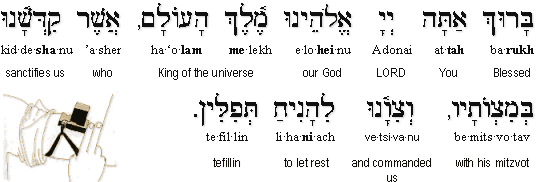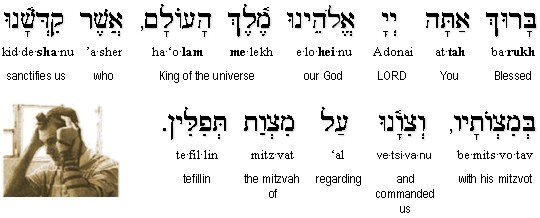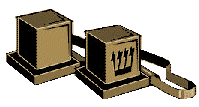|
|
 |
 |
|
TEFILLIN ARE VERSES from Torah written on kosher parchment and placed within leather boxes (batim) with leather straps attached to them. These straps are used to bind the batim to one's arm/hand (Tefillin shel Yad) and to one's head (Tefillin shel Rosh) in obedience to Deuteronomy 6:8 ("And thou shalt bind them for a sign upon thine hand, and they shall be as frontlets between thine eyes"). The customary practice is to wear Tefillin during the entire weekday morning (Shacharit) service but not during Shabbat or holidays.
The two batim each contain four sections of the Torah. There are various script styles that may be used, including Bet Yosef and Sephardic varieties. The Torah passages are:
|
 |
 |
|
The Tefillin shel Rosh is placed upon the head, above the forehead, resting upon the brain.
When putting on tefillin, Ashkenazi Jews stand, whereas Sephardic Jews sit. The custom is that while donning the tefillin, you must not talk from after the first blessing through finishing of the ritual.
|
 |
 |
|
First, put on the Tefilin shel Yad
While standing, roll up your (left) sleeve and remove any rings and watches from that hand. Unwrap the straps and take the shel yad out of the box. Open the loop and position the shel Yad on the center of your biceps.
Recite the first blessing:
|
 |
 |
|
Blessed art Thou, LORD our God, King of the universe, who has sanctified us with his commandments and commanded us to wear tefillin.
|
 |
 |
|
Barukh attah Adonai eloheinnu melekh ha-olam asher kiddeshanu
bemitzvotav vetsivanu lehani'ach tefillin.
|
 |
 |
|
Tighten the loop, and begin wrapping the strap around your hand. Wrap at least once around your biceps, and seven times around your lower arm. Stop at the palm, and wrap the remainder of the strap around your palm.
Note that you will not wrap the fingers with the excess strap (that is wrapped around your palm) until later, after putting on the shel Rosh.
|
|
|
 |
 |
|
Next, put on the Tefillin shel Rosh
Remove the shel Rosh from the bag, unwrap the straps, and take it out of the box.
Place the shel Rosh on your head just before the hairline. The knot should be behind your head - just above your neck, and the strap should be lying loosely on your head.
Recite the blessing:
|
 |
 |
|
Finally, you will finish wrapping the strap of the shel Yad over the fingers.
- Unwind the excess strap that you temporarily wrapped around your palm.
- As the strap comes from the wrist, wrap it around the upper part of the middle finger once.
- Lead the strap down a bit and then wrap around the lower part of the middle finger twice.
- Lead the strap around the third finger across to the index finger, and then repeatedly around the palm until it runs out.
- Finally, tuck the last stretch of the strap underneath the winding on the palm side.
You are now ready to "daven" (pray) the Shema and the Amidah.
|
 |
 |
|
Removing the Tefillin
|
 |
 |
|
Generally speaking, you will proceed in the opposite order in which you put on the tefillin:
- Unwrap the strap of the shel Yad from your fingers, wrapping the excess strap
around your fist.
- Loosen and remove the shel Rosh, carefully wrapping the strap neatly in its box.
- Loosen and remove the shel Yad from your arm, wrapping the strap neatly and putting it back into its box.
|
|
|
 |
 |
|
The letter Shin appears engraved on both sides of the head tefillin. On the right side, the Shin has three heads, while on the left side it possesses four. If you look closely, it is possible to see an additional three-headed Shin formed from the spaces between the four heads. The three-headed Shin is the Shin of this world, while the four- headed Shin is the Shin of the World to Come.
|
|
 |
 |
|
Phylacteries?
|
 |
 |
|
The Greek word ¤ёрй░ ¤є¤Ё╬╗╬▒╬║¤ёрйх¤Ђ╬╣╬▒ was transliterated as "phylacteries" by translators of the English New Testament. It does not appear in the LXX (Septuagint) but the word р╝ђ¤Ѓ╬▒╬╗╬х¤Ё¤ё¤ї╬й does, which was used to translate the Hebrew word "totafot" (frontlets) in the verse "And it shall be for a token upon thine hand, and for frontlets between thine eyes (Оюо░ОўОЋо╣ОўоИОцОф ОЉо╝охОЎОЪ ОбохОЎОаоХОЎОџоИ): for by strength of hand the LORD brought us forth out of Egypt" (Exod. 13:16).
The word tefillin (Офо╝о░Оцо┤ОЎОюо╝о┤ОЎОЪ) is probably Aramaic, not Hebrew, though it is obviously related to the Hebrew word "tefillah" (prayer). The word tefillin does not occur in the Torah itself, but rather in the Oral Torah and traditions of the sages/rabbis. The idea that "totafot" (ОўОЋо╣ОўоИОцОф) placed "between your eyes" (Exod. 13:9, 6, Deut. 6:8, 11:18) actually refers to the elaborate rules and ceremonies attached to modern tefillin usage is a rabbinical invention. Metaphorically, of course, the idea of totafot means practicing the Presence of the LORD and remembering your identity as a redeemed Jew every moment the day...
Yeshua warned about confusing the inner with the outer: "But they do all their deeds to be noticed by men; for they broaden their phylacteries (tefillin) and lengthen the tzitzit of their garments" (Matt. 23:5). Most likely this was intended to be a warning that one shouldn't affect religiosity before men in a vain attempt "to be seen" as righteous/zealous.
|
|









